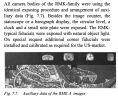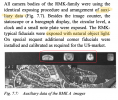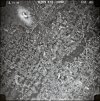If it is a lens flare/reflection then,
1.What is the source of the reflected light?
My understanding of lens flares is that they are typically caused by light just outside of the frame.
Source:
https://en.wikipedia.org/wiki/Lens_flare
2. Could the source of the light be an object on the ground reflecting back up at the camera?
I arranged the three frames in a mosaic along the guides lines in this document.
Source:
http://www.edc.uri.edu/nrs/classes/NRS409/RS/Lectures/409509Class2-2008.pdf
(pink line is the direction of flight taken by connecting the principle points of each photo, yellow is the direction of sunlight, green is a proposed path from a source of reflected light to the object).


There is one building which appears in frame 299 but which is just outside of frame 300.
3. Could that building be momentarily reflecting light from the east back up at the camera to produce the flare/reflection?
4. If it could be an effect produced from a reflecting object on the ground I wonder if this is the reason for the deliberate removal of such items in the recent drum scan. It could also be from one of the white objects beside the lake much closer to the object that were removed. See examples in [#175]
5. If it is a lens flare/reflection wouldn’t you expect the see streaking across the image such as in these examples? (
However these are taken from an oblique angle not vertical). The camera in the Lake Cote photo is tilted slightly in the direction of the planes flight.

Source:
https://britainfromabove.org.uk/en/image/SPW047884

Source:
https://britainfromabove.org.uk/en/image/SPW022108
There are a few examples of lens flares/reflections on Google earth images taken from a vertical position. However they all appear to be when the light is reflecting directly off the object to the camera.

Source:
Source: https://www.reddit.com/r/mildlyinteresting/comments/1c17j8/some_place_on_google_maps_has_some_intense_lens/
5. If it's not light from a source on the ground what other source could produce this effect? A reflection off part of the aircraft? Something else out of the frame?
6. Are there
any examples of lens flares/camera reflections in vertical aerial photography that don't also have connecting streaks?



